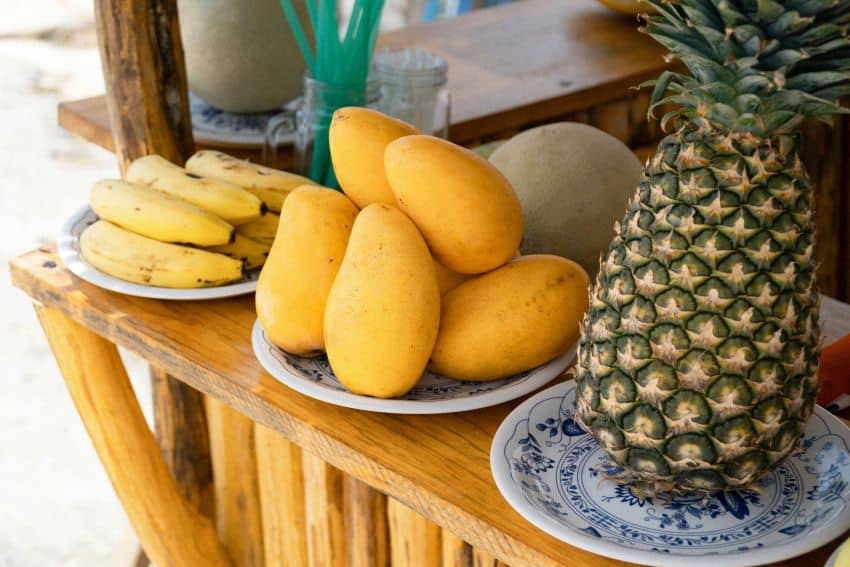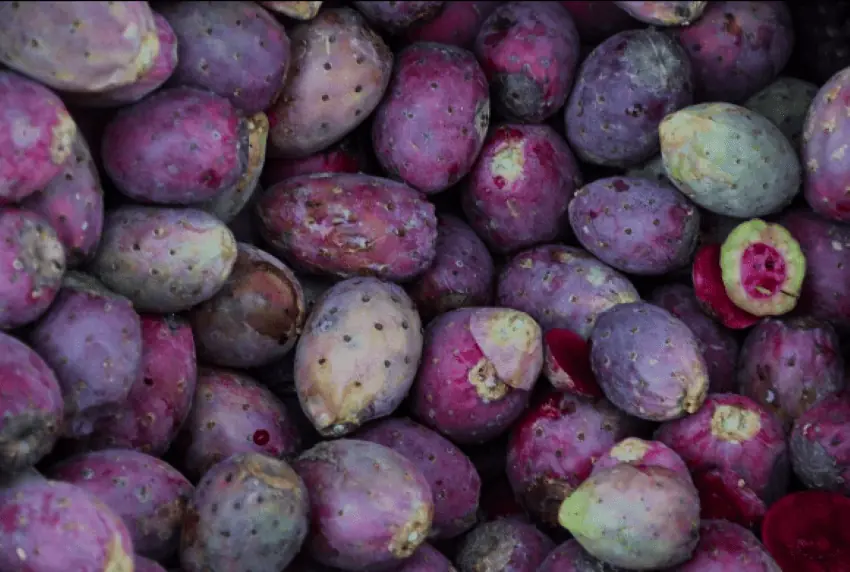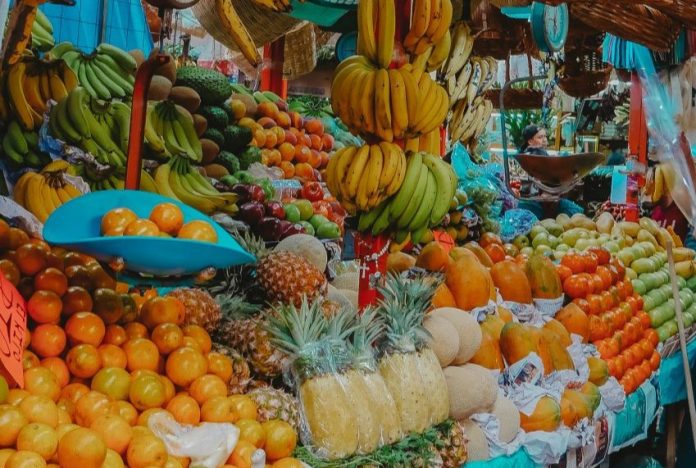Sundays are my favorite day of the week. I wake up and head to my favorite cafe before making my way to the market to stock up on a week’s worth of colorful fruits and vegetables.
One of the greatest perks of living in Mexico is easy access to seasonal produce, with fruits being exceptionally abundant. The health benefits of regular fruit intake are numerous, made more so by the fact that what can be found at the tianguis (market) is sold according to season.

When fruits ripen naturally, they’re full of nutrients and flavor that are otherwise lost in the artificial maturation process. Because Mother Nature is so smart, she offers what we need, when we need it — have you ever wondered why blueberries peak in the summer? The high level of antioxidants help protect your skin from sun damage.
There’s an intuitive natural cycle to all this, a cycle that unfortunately has been lost in countries like the U.S., Canada, and the U.K., which largely source produce year-round, from across the globe, and long before the product has reached ripeness. To add to that, long-distance travel leads to further loss in nutritional value as well as being bad for the environment.
I used to eat overpriced and under-ripened mangoes all year long in the States. In Mexico, I opt for juicy pineapple in the winter and enjoy fully matured mangoes in the summer. It feels better for my body and it’s cheaper, too!
Mexico harvests 20.5 million tons of fruit annually, much of which is exported to its two top trading partners — Canada and the United States. Nonetheless, produce markets in Mexican towns and cities overflow with national produce according to availability — just follow our handy preparation guide and enjoy.
So if you’re ready to dive into the wide world of Mexican fruit, here’s an easy guide for my fellow fruit lovers to refer to throughout the year!
Mangos
Eaten in a multitude of ways in Mexico, mangoes can be found in everything from ceviche to smoothies. There are hundreds, if not thousands, of mango varieties across the world and at least a dozen of those are produced in Mexico. Popular types include Ataúlfo, Haden, Tommy Atkins, and Kent, each with its own particular flavor and sweetness.
The golden “king of fruit” was likely introduced to Mexico from Asia via the Spanish conquistadores, thriving in the rich environments of the Pacific and Southern coasts in states like Michoacán, Chiapas, Sinaloa, and Guerrero.
Season: Staggered according to type, but generally available from March to September.
Nutrients: High in vitamin C, vitamin A, and fiber.
Health benefits: Supports immune function, promotes healthy skin, and aids digestion.
Avocado
The national fruit of Mexico is actually a berry, yet it is rarely found in a fruit salad. At their ripest, avocados are creamy and filling, acting as an excellent cheese substitute for vegans. Enjoy them guacamole-style with chips, sliced on huevos rancheros, or alone with salt.
There are reportedly over 500 types of avocados, which fall into three groups: Indian, Guatemalan — and, you guessed it — Mexican, which is the world’s largest producer and exporter. Michoacán’s rich, volcanic soil and sunny climate lends itself to year-round cultivation and remains the country’s leading provider.
Season: Year-round
Nutrients: High in healthy fats, fiber, vitamins, and minerals.
Health benefits: Supports heart health, improves digestion, and promotes healthy skin.
Pineapple
Without it, would tacos al pastor even exist? The biggest producer of pineapple is Costa Rica, but Mexico follows close behind. The sweet-and-tangy treat is grown mostly in Veracruz and is often sold on the street in its natural state or in agua fresca during the season.
Season: October to July, with the highest output in June and July.
Nutrients: Contains bromelain, vitamin C, fiber, and manganese.
Health benefits: Supports digestion and immune function, reduces inflammation.
Prickly Pear

Recent arrivals in Mexico might have run into confusion with this one, as prickly pears are locally referred to as tuna. In their natural form, they are, indeed, quite prickly, sprouting from the staple nopal cactus.
The egg-shaped fruits are usually sold with the spikes removed, just like nopales, and can be green, yellow, pink, or red on the outside. Removing the thick skin unveils a delicate green or red filling with black seeds and a flirty, floral taste. Ingest as a juice, a marmalade, or simply as is.
Eight varieties can be found in Mexico, with growth concentrated in the State of México, Puebla, and Zacatecas.
Season: Starting in April, production peaks in July through September.
Nutrients: Fiber, vitamin C, magnesium, copper, potassium
Health benefits: Lowers blood sugar levels, protects against oxidative damage caused by free radicals, supports digestive health and prevents constipation.
Guava (guayaba)
Fun fact: Guava has the highest level of Vitamin C of any fruit. It’s the main ingredient of the popular antigripal juice drink due to its flu-fighting qualities (hence the name). You’ll find it as a compote for desserts or in atole, often paired with a sweet Rosca de Reyes cake consumed on Three Kings Day.
The majority of guavas are cultivated in Michoacán, Aguascalientes, and Zacatecas. Some, like the apple or china guava, are white on the inside and others, like the strawberry guava, are pink.
Season: August to February
Nutrients: High in vitamin C, fiber, and antioxidants.
Health Benefits: Supports immune function, aids digestion, and promotes healthy skin.
Papaya
When ripe, papaya has a smooth and honey-like flavor. Eat it alone, in a smoothie, or caramelized with cheese. Many people discard the black seeds on the inside, though I find them quite tasty and always add a few to my smoothie or with chopped papaya. Traditional medicine suggests that the seeds have anti-parasitic properties.
Papaya was a symbol of fertility for the Maya and today is found mainly in Oaxaca, Chiapas, and Colima.
Season: Year-round
Nutrients: High in vitamins A, B6, and C, potassium, lycopene, magnesium, and digestive enzymes.
Health benefits: Supports eye health, relieves diarrhea, fights intestinal parasites, protects against cancer, brightens skin.
Mamey (sapote)
The brown, dusty outer peel of the mamey sapote contrasts greatly with its bright, salmon-colored interior. This nutrient powerhouse has a flavor that is hard to describe, falling somewhere between brown sugar and a sweet potato. It’s generally eaten in fruit salad, smoothies, milkshakes, or as a sweet sauce for pork.
Mamey sapote comes from Yucatán, and can be found in markets throughout most of the year.
Season: Year-round, but production peaks in January through March.
Nutrients: High levels of vitamin B6, vitamin C, copper, vitamin E, potassium, riboflavin, niacin, manganese, and pantothenic acid.
Health benefits: Supports brain function, prevents constipation, has anti-aging effects through collagen synthesis stimulation, combats anemia by producing red blood cells.
Mandarins
Originally from Asia, which could explain the name, mandarin season kicks off around Day of the Dead. The tiny, brightly-hued globes are a staple item on traditional altars. For consumption, they are largely enjoyed in the form of a freshly squeezed jugo de mandarina, deeper in color than orange juice. You will also see them as marmalades, salsas, and baked into pan dulce.
The states of Veracruz, Puebla, and Nuevo León harvest more than 80% of Mexico’s mandarins.
Season: October to January
Nutrients: High in vitamins C, B1, B2, and B6, phosphorus, calcium, and iron.
Health benefits: Reduces risk of cancer, combats infection, supports bone health, boosts immunity.
Happy shopping!
Bethany Platanella is a travel planner and lifestyle writer based in Mexico City. She lives for the dopamine hit that comes directly after booking a plane ticket, exploring local markets, practicing yoga and munching on fresh tortillas. Sign up to receive her Sunday Love Letters to your inbox, peruse her blog, or follow her on Instagram.
